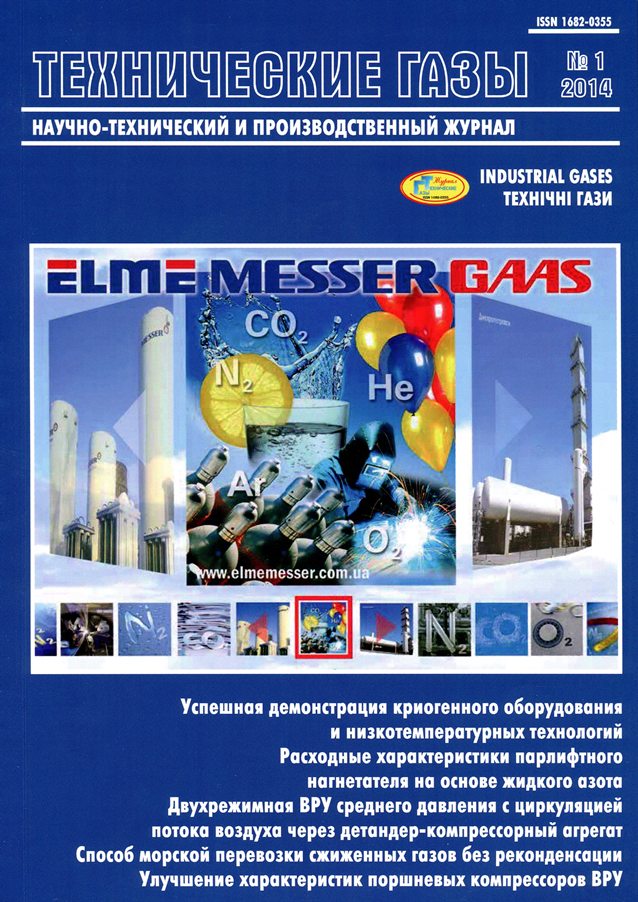АНАЛИЗ ЭФФЕКТИВНОСТИ РАЗЛИЧНЫХ СПОСОБОВ ИСПАРИТЕЛЬНОГО ОХЛАЖДЕНИЯ ВОДЫ И ВОЗДУХА
DOI:
https://doi.org/10.18198/j.ind.gases.2014.0715Ключевые слова:
Испарительное охлаждение, Вода, Воздух, Прямое испарительное охлаждение, Непрямое испарительное охлаждение, Регенеративное непрямое испарительное охлаждение, Комбинированное непрямое испарительное охлаждение, Адиабатическое охлаждение воздухаАннотация
Атмосферной воздух и вода являются эффективными и доступными агентами, позволяющими обеспечивать отвод тепла от технологического оборудования в окружающую среду. Для многих установок, работающих практически круглогодично, критическим из-за повышения температуры окружающей среды является летний период. Для стабилизации работы теплообменного оборудования в этот период необходимо обеспечивать температуру оборотной воды не выше 28 °С. Рассмотрены различные процессы охлаждения воды и воздуха в контактных аппаратах — вентиляторных градирнях. Выполнен анализ изменения параметров атмосферного воздуха, который подаётся в градирню для охлаждения циркулирующей воды. Показано, что предельная температура охлаждения воды и перепад температур определяются способом предварительного охлаждения воды и параметрами атмосферного воздуха. Наиболее эффективный способ охлаждения воды — комбинированное непрямое испарительное охлаждение воздуха перед его подачей в градирню. Это позволяет добиться охлаждения циркулирующей воды оборотной системы до температур близких к температуре точки росы 17…22 °С.
Библиографические ссылки
Shvets S.G. (2006). Waterrecycling systems of compressor equipment for manufacturing// Tekhnicheskie Gazy. [Industrial Gases].— № 6. — P. 30-37. (Rus.).
Lapshin A.A. (2012). Mathematical modeling of the cooling air injector irrigation// Gіrnichy visnyk Naukovo-tehnіchny zbіrnik. — Вып. 1. — P. 85-89. (Rus.).
Kokorkin O.Ya. (1978). Installation of air conditioning. Basis of calculation and design . Ed. 2nd , revised . and add. — Moscow: Mechanical Engineering. — 264 p. (Rus.).
Arsiriy V.A., Tamer N.A. Bannura. (2009). Cooling water in the cooling tower to atmospheric dew point of air// Proceedings of the Odessa Polytechnic . Univ. — Edit. 2. — P. 73-77.
Lavrenchenko G.K., Doroshenko A.V. (1988). Development of evaporative air coolers indirectly conditioning systems// Kholodilnaya tekhnika. [Refrigeration Engineering]. — № 10. — P. 33-38. (Rus.).
Doroshenko A.V., Filiptsov S.N., Gorin A.N. (2004). Evaporative coolers and indirect types of combined// Kholodilnaya tekhnika i tekhnologiya. [Refrigeration Equipment and Technology]. — № 6. — P. 15-22. (Rus.).
Maisotsenko V., Gillan L. (2003). The Maisotsenko Cycle for Air Dessiccant Uses Heat Culling// Proc. Intern. Congress of Refrigiration. — Washington, — Р. 57-59.
Gorin A.N., Doroshenko A.V. (2007). Alternative refrigeration systems and air conditioning systems . Ed. 2nd , revised. and add. — Donetsk: Nord-Press, — 362 p. (Rus.).
Rozum M.V., Doroshenko A.V., Vasyutinskiy S.Yu. (2012). Efficiency of the processes of heat transfer in the indirect evaporative cooler monobloc type// Kholodilnaya tekhnika i tekhnologiya. [Refrigeration Equipment and Technology]. — № 4. — P. 58-67. (Rus.).
Doroshenko A.V., Rozum M.V., Lisogurskaya O.A. (2013). Multistage evaporative coolers for refrigeration and air-conditioning systems// Kholodilnaya tekhnika i tekhnologiya. [Refrigeration Equipment and Technology]. — № 1. — P. 24-34. (Rus.).
Doroshenko A.V., Rzhesik K.A., Gordienko M.V. (2013). New opportunities for energy evaporative coolers and refrigeration systems// Kholodilnaya tekhnika i tekhnologiya. [Refrigeration Equipment and Technology]. — № 6. — P. 4-11. (Rus.).
Загрузки
Выпуск
Раздел
Лицензия
ЛИЦЕНЗИОННЫЙ ДОГОВОР
После приёма статьи к публикации редакция согласно требованиям наукометрических баз каждому из авторов направляет лицензионный договор об уступке и передаче в управление авторских прав. Подписи автора (авторов) желательно скрепить печатью отдела кадров учреждения, в котором работает автор (авторы), или печатью факультета.
Редакция отсылает авторам одну верстку для корректуры. Допустимы лишь те исправления, которые приводят верстку в соответствие с исходным текстом статьи. Внесение существенных изменений не допускается. Верстку следует выслать в редакцию в течение суток с момента получения.

